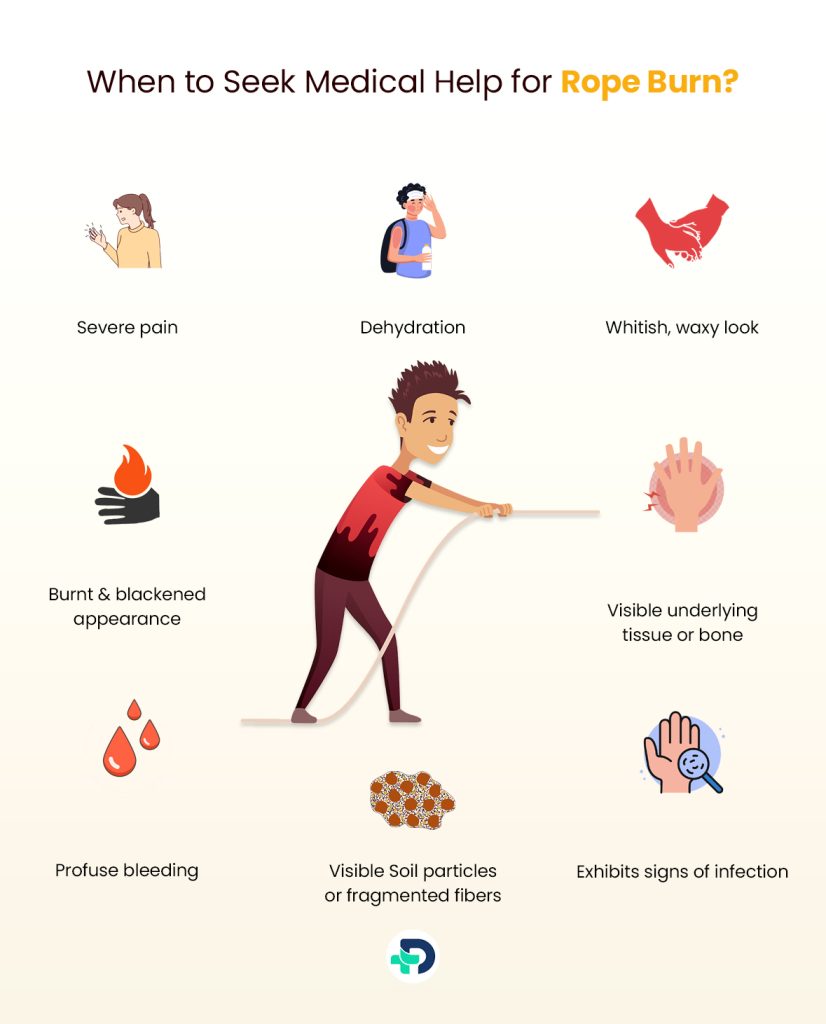How To Treat Rope Burn? Complications & Recovery

- Burns
- 12 Oct 2023
Introduction
What is a Friction Burn?
Friction burns refer to injuries caused by the application of forceful frictional forces on the skin, resulting in tissue damage. These burns are distinct from other types of burns due to their etiology and the mechanisms through which they occur. 1 Introduction | Researched based study from National Institutes of Health Friction burns can be characterized as a combination of blunt force trauma and thermal injury, with their severity being exacerbated by high velocity. Friction burns are not categorized strictly as thermal burns or abrasions, as they possess characteristics that align with both types of injuries. Friction burns occur as a result of the mechanical action of rubbing against the skin, leading to the generation of heat through contact. 1 Introduction | Researched based study from National Institutes of Health This heat accumulation can eventually cause the skin to undergo a burning sensation, irrespective of the initial temperature of the surface involved. Consequently, friction burns are commonly treated using similar methods as thermal burns, despite being categorized as abrasions.

Rope Burn
What is a Rope Burn?
A rope burn refers to a type of injury that occurs when friction between a rope and the skin results in damage to the superficial layers of the dermis. 4 Rope Burn | Researched based study from National Institutes of Health A rope burn is classified as a form of friction burn. The phenomenon is attributed to the swift or recurrent motion of a rough cord coming into contact with the skin. This action causes friction on the skin, leading to:
- Redness
- Irritation
- Occurrence of blisters
- Blood loss from the body
Rope burns may exhibit superficial characteristics, wherein they solely impact the outermost layers of the integumentary system. Although less probable, it is possible for wounds to penetrate deeply, reaching the dermis layer and potentially exposing the underlying bone. 4 Rope Burn | Researched based study from National Institutes of Health
Rope burns may manifest as a consequence of various activities, including:
- The activity commonly referred to as “tug-of-war”
- Aerial acrobatics
- The activity of rock climbing
- Management of livestock on agricultural premises
- Camping and boating activities.
Classification
Classification of Rope Burn Severity
Rope burns of the first degree
- First-degree burns, sometimes referred to as minor burn degrees, primarily impact the epidermis, which is the outermost layer of the skin.
- The skin will exhibit a reddish hue and elicit a sensation of tenderness. Nevertheless, the absence of moisture or blister formation will be observed.
- The burn has the potential to undergo spontaneous healing, however it can also benefit from the application of topical treatment. The wound is shallow in nature and the probability of scarring is low. 4 Classification | Researched based study from National Institutes of Health
Friction burns of the second degree
- Second-degree friction burns involve damage to both the epidermis, which is the outer layer of the skin, and the underlying dermis, which is the deeper layer of the skin.
- The wound will have not just a reddish hue, but also a glossy or moist appearance. The affected area is likely to elicit pain upon contact and may develop blisters as time progresses.
- The necessity of medical assistance for the healing of this burn is contingent upon its depth. Scarring may occur.
Friction burns of the third degree
- Third-degree friction burns are characterized by the extensive destruction of both the epidermis and dermis layers of the skin.
- These burns typically penetrate deeply and are often devoid of pain due to the significant damage inflicted upon the nerves.
- The burn wound bed may exhibit colors such as black, brown, white, or yellow, which are contingent upon the etiology of the injury and its depth.
- Medical intervention is necessary for the healing of third-degree friction burns. There exists a significant likelihood of scarring. 4 Classification | Researched based study from National Institutes of Health
First Aid
First Aid for Rope Burn
Essential materials to possess for the management of rope burns encompass:
- Access to clean water
- Apply topical aloe 2 First Aid | Researched based study from National Institutes of Health
- Sterile gauze pads for wound care and dressing changes
- Cotton gauze tape
- Sterile tweezer
In the event of sustaining a rope burn, it is recommended to follow the subsequent steps:
- Evaluate the nature and severity of the wound.
- Assess the extent of the rope burn.
- It is advisable to seek medical attention for any rope burn exceeding a size of 2 to 3 inches or penetrating beyond the superficial layer of the skin. 2 First Aid | Researched based study from National Institutes of Health
- In the event that medical assistance is required, it is advisable to cleanse and dress the wound in order to mitigate the risk of infection.
- Subsequently, promptly contacting local emergency services or proceeding to an emergency facility is recommended.
Perform wound cleansing
- It is recommended to cleanse all rope burns by employing cool running water. This process aids in the elimination of debris, germs, and shards of rope from the wound.
- In the event that a source of running water is not accessible, it is advisable to utilize a cool compress or standing water that has been sanitized as an alternative.
- It is advised to refrain from applying ice to the wound, since doing so may potentially exacerbate tissue damage. 3 First Aid | Researched based study from Academia.edu
- In the event that there are residual rope fragments that are not easily washed away, one may opt to retain them for professional extraction by a medical practitioner or cautiously attempt their removal using a sterilized pair of tweezers.
- It is advisable to exercise caution in order to prevent exacerbating the wound by refraining from pulling or causing more abrasion while attempting to extract shards or debris.
- The topical application of aloe is recommended. Typically, the application of topical aloe vera is sufficient in alleviating discomfort.
- Avoid the usage of butter, since it may potentially harbor bacteria that could result in the onset of infection.
Apply a dressing to the injured area
- It is recommended to maintain cleanliness and dryness of the wound by use a gauze bandage or wrap.
- It is advisable to apply a gentle wrapping to the injured region, as opposed to a tight one. 2 First Aid | Researched based study from National Institutes of Health
Complications

When to Seek Medical Help for Rope Burn?
It is advisable to promptly get medical intervention for a rope burn when accompanied by any of the following symptoms: 3 Complications | Researched based study from Academia.edu
- Severe pain
- Dehydration
- Burnt and blackened appearance
- Whitish, waxy look
- Visible underlying tissue or bone
- Profuse bleeding
- Visible Soil particles or fragmented fibers
- Exhibits signs of infection
- Absence of pain (as it is attributed to the destruction of nerve endings within the dermis). 3 Complications| Researched based study from Academia.edu
Treatment
How to Treat Rope Burn?
The sensation of pain resulting from rope burns may persist for a duration of many days.
- Over-the-counter analgesics have the potential to mitigate pain. It is imperative to adhere to the prescribed dosage and avoid surpassing the permissible limit. In the event that the intensity of your pain escalates or fails to ameliorate over a span of five days, it is advisable to seek medical attention. 3 Treatment | Researched based study from Academia.edu
- It is imperative to maintain cleanliness and dryness of the bandage. It is recommended to replace sterile bandages on a daily basis, or more frequently if they become damp or soiled.
- During each bandage change, it is advisable to reapply a layer of topical aloe, taking caution to avoid applying pressure on the wound.
- Please proceed with the ongoing evaluation of the wound. In the event that symptoms such as redness, puffiness, or indications of infection manifest, it is advisable to consult a medical professional. 2 Treatment | Researched based study from National Institutes of Health
- It is advised to refrain from rupturing any blisters that may manifest within the wound. It is advisable to engage in self-monitoring for indications of dehydration and maintain enough hydration by consuming ample amounts of water.
- The healing process of the wound is expected to occur within a timeframe of approximately 7 to 10 days.
- The cessation of covering the area is appropriate once the integumentary tissue has fully regenerated.
- In the event that medical attention is necessary for a rope burn, it is advisable to adhere to the precise suggestions provided by a healthcare professional.
Recovery
Stages of Healing in Rope Burns
In the case of minor friction burns:
- The burn may exhibit characteristics such as erythema, edema, and exudation.
- Over the course of time, the edema is expected to subside, while the wound will gradually desiccate, leading to the formation of a scab.
- Pruritus, or itchiness, can commonly manifest in the skin or scab throughout the process of wound healing. 4 Recovery | Researched based study from National Institutes of Health
- It is advised to refrain from picking at the scab. This phenomenon has the potential to heighten the likelihood of infection and the formation of scars.
- In the event that the wound displays persistent alterations in coloration, heightened sensitivity or escalating pain, or the emergence of new symptoms such as discharge or an unpleasant odor, it is imperative to promptly seek medical intervention, since there exists a possibility of wound infection.
In the case of severe friction burns:
- In cases of severe friction burns, it is imperative to implement appropriate medical interventions to mitigate the extent of tissue damage and promote optimal healing.
- Severe friction burns are characterized by their significant depth and potential to impact the subcutaneous layers of tissue. Autonomous healing is not feasible, necessitating the intervention of healthcare practitioners for effective treatment.
- In the absence of appropriate medical intervention, an infection has the potential to develop and give rise to significant consequences. 4 Recovery | Researched based study from National Institutes of Health
- It is probable that severe friction burns will undergo debridement or cleansing procedures. The medical technique entails the extraction of foreign matter and necrotic tissue from the wound site.
- After the completion of the aforementioned procedure, the surgeon may determine that a skin graft is necessary for the wound to undergo healing.
- The skin transplant has the potential to be of a transitory nature, and in such instances, it will be extracted within a span of few weeks, thereby exposing the presence of rejuvenated and healthy skin beneath.
- In the event that the skin graft is deemed permanent, it will not be subject to removal. Patients should be provided with home care based on the instructions provided by their surgeon.
- It is probable that scarring will occur. There are many options for scar revision that might be considered in cases where the scarring is significant and has a noticeable impact on one’s appearance or ability to function.
How long do burns take to heal?
The duration of the healing process is contingent upon the extent of the rope burn’s severity.
- First-degree burns normally exhibit a healing period ranging from three to six days, while certain instances may necessitate up to 10 days for complete resolution.
- The healing process for second-degree burns often requires a duration of two to three weeks or possibly an extended period of time. In certain cases, it may be necessary to have surgical intervention for the purpose of excising necrotic skin or performing a skin graft procedure.
- Skin grafting and a prolonged healing period are necessary for third- and fourth-degree burns.
Prevention
Methods to Prevent Rope Burn
- Utilization of appropriate clothes to provide a protective barrier between the skin and the rope minimizes the potential contact points. This entails the utilization of gloves, trousers, and shirts with long sleeves, even when the climate is warm. 1 Prevention | Researched based study from National Institutes of Health
- Ensuring rope safety during sports and activities necessitates adopting a reasonable approach.
- One should exercise caution to prevent entanglement in ropes while navigating boat decks.
- It is advisable to exercise caution while navigating around ropes within campgrounds, and to be mindful of preventing inadvertent entanglement with rope loops.
- It is imperative to educate youngsters about the potential hazards associated with mishandling ropes prior to their participation in rope-related activities. 1 Prevention | Researched based study from National Institutes of Health
- It is advisable to don gloves while engaging in the activity of tug-of-war. Rapid occurrence of rope burns may ensue when multiple individuals exert force on a rope simultaneously.
- Refrain from attempting to seize a rope that is being forcibly withdrawn by an individual, watercraft, or motor vehicle, unless one’s personal safety is at imminent risk.
Takeaway
Rope Burn: Take Care to Avoid Infection
Although minor friction burns are frequently encountered and generally do not necessitate medical intervention, it is imperative to thoroughly cleanse the wound in order to prevent the occurrence of infection. Friction burns have the potential to accumulate dirt and debris within the wound site, necessitating thorough cleansing prior to the commencement of the healing process.
Severe friction burns may manifest through a multitude of mechanisms. Friction burns can be caused by various sources, including blenders, factory machinery, conveyor belts, elevators, and other similar mechanisms. Maintaining situational awareness and implementing suitable safeguards represent two effective strategies for mitigating the risk of experiencing unpleasant friction burns or necessitating a visit to a burn center.
Any feedback on this article?
 This Articles content was accurate
This Articles content was accurate Very Informative Article
Very Informative Article I have a question or a comment
I have a question or a comment
 This article contains inaccurate content
This article contains inaccurate content This article was not helpful
This article was not helpful I have a question or a comment
I have a question or a comment
We appreciate your helpful feedback!
Checkout our social pages
References
-
National Institutes of Health
Introduction | Prevention
-
National Institutes of Health
First Aid | Treatment
-
Academia.edu
First Aid | Complications | Treatment
-
National Institutes of Health
Rope Burn | Classification | Recovery Stages






































